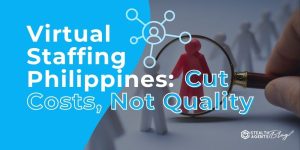Outsourcing social media analytics services has become a game-changer for businesses aiming to sharpen their digital strategies.
As of 2023, the global data analytics outsourcing market was valued at $12.12 billion and is projected to grow significantly, reflecting the increasing reliance on outsourced expertise to interpret complex data.
Similarly, the social media analytics market is expected to register a compound annual growth rate (CAGR) of 24.9% from 2023 to 2028, highlighting analytics’ critical role in social media success.
By leveraging outsourced social media analytics, businesses can gain deep insights into their audience behaviors, optimize content performance, and drive more effective engagement strategies.
Stealth Agents stands ready to assist companies in finding or outsourcing top-tier social media analytics services, offering a complimentary discussion to tailor solutions and explore virtual assistant pricing.
What is Social Media Analytics?
Social media analytics involves collecting, analyzing, and interpreting data from social media platforms to make informed business decisions.
Many businesses use outsourced social media content creation services to complement their analytics efforts, ensuring that the content aligns with data-driven insights.
It helps businesses understand their audience, measure the effectiveness of their social media strategies, and optimize their content for better engagement and reach.
By leveraging social media analytics, companies can gain insights into trends, user behavior, and the overall impact of their social media efforts.
Why is Social Media Analytics important?
Social media analytics is essential for businesses. It provides deep insights into audience behavior and enables more targeted and effective marketing strategies.
It helps measure the performance of social media campaigns, optimize engagement by identifying the best content and posting times, and conduct competitive analysis to stay ahead in the market.
Additionally, it aids in calculating ROI, ensuring resources are used effectively, and supporting data-driven decision-making for strategic success.
Furthermore, social media analytics is critical in crisis management because it identifies potential issues early and allows timely intervention. By leveraging these insights, businesses can significantly enhance their social media presence and drive overall growth.
What are the Most Common Outsourced Social Media Analytics?
-
Performance Tracking:
Monitoring and analyzing the performance of social media campaigns is crucial for understanding how well your strategies are working. This involves tracking metrics such as engagement rates, which include likes, comments, and shares, as well as reach and impressions to gauge the visibility of your content.
Conversion rates are also closely analyzed to determine how many social media interactions lead to desired actions, such as website visits or purchases.
By continuously tracking these metrics, businesses can identify successful tactics and areas needing improvement, ensuring the optimization of their social media efforts.
-
Audience Analysis:
Understanding your audience’s demographics, interests, and behaviors allows for more personalized and effective marketing. This analysis involves collecting data on your followers’ age, gender, location, and online behaviors.
By leveraging this information, businesses can create content and campaigns that resonate more deeply with their target audience. For instance, a brand targeting young adults might focus on platforms like Instagram and TikTok, where this demographic is most active.
Audience analysis helps you tailor messages that align with your followers’ interests and preferences, ultimately leading to higher engagement and loyalty.
-
Content Analysis:
Evaluating the effectiveness of different types of content helps determine what resonates best with your audience. This involves analyzing various content formats, such as text posts, images, videos, and stories, to see which types generate the most engagement.
For example, a brand may find that video content receives more views and shares than static images. Content analysis also includes assessing the performance of specific themes or topics to identify what interests your audience most.
By understanding these preferences, businesses can focus on creating and sharing content that maximizes audience interaction and satisfaction.
-
Sentiment Analysis:
Assessing the sentiment of social media mentions and comments provides insights into public perception and brand reputation. Sentiment analysis uses algorithms to categorize mentions as positive, negative, or neutral.
This helps businesses understand how the public perceives their brand and identify potential issues early. For example, a spike in negative sentiment might indicate a problem with a recent product launch or a customer service issue.
By addressing these concerns promptly, companies can mitigate the impact on their reputation and improve customer satisfaction.
-
Competitor Analysis:
Monitoring competitors’ social media activities helps identify trends, strategies, and opportunities for differentiation. This involves tracking competitors’ posts, engagement rates, and follower growth to gauge their performance.
Businesses can refine their strategies by learning from their competitors’ successes and failures. For instance, if a competitor’s campaign goes viral, analyzing its elements can provide valuable insights for your next campaign.
Competitor analysis also helps identify gaps in the market that your brand can fill, giving you a competitive edge.
-
Trend Analysis:
Identifying and analyzing emerging trends on social media is vital for staying relevant and capitalizing on new opportunities. Trend analysis involves tracking hashtags, popular topics, and viral content to understand what is currently capturing public interest.
For instance, specific themes may trend more than others during significant events like holidays or industry conferences.
Aligning your content with these trends can increase visibility and engagement. Staying ahead of trends also positions your brand as a thought leader and keeps your marketing efforts fresh and appealing.
-
Influencer Analysis:
Evaluating the impact and effectiveness of influencer partnerships and campaigns ensures that collaborations benefit both parties. Influencer analysis involves tracking engagement rates, reach, and follower growth from influencer content.
It also includes measuring the direct impact on sales or conversions attributed to influencer promotions. For instance, you can expand your reach and credibility by partnering with an influencer whose followers match your target demographic.
Continuous analysis helps select the right virtual assistant influencers and optimize future collaborations for maximum impact.
-
ROI Analysis:
Calculating the return on investment for social media activities ensures that resources are used efficiently. This involves comparing the costs of social media campaigns against the revenue or value generated from them.
ROI analysis helps determine which campaigns provide the best return and which may need adjustments. For example, sponsored posts or paid ads should be assessed to see if they drive sufficient traffic and conversions relative to cost.
By understanding the financial impact of social media efforts, businesses can allocate their budgets more effectively and prioritize high-performing strategies.
-
Crisis Management:
Detecting and managing potential issues or negative trends early is critical for protecting a brand’s reputation. Crisis management involves monitoring social media for signs of emerging problems, such as spikes in negative mentions or viral complaints.
Businesses can respond quickly and effectively to mitigate damage by identifying issues early.
For instance, addressing a customer complaint publicly and transparently can prevent further backlash. Proactive crisis management also involves planning for potential scenarios and ensuring your team is prepared to handle challenges swiftly and professionally.
-
Reporting and Insights:
Providing detailed reports and actionable insights informs strategic decision-making and continuous improvement. Reporting involves compiling and presenting data on key metrics.
These reports highlight successes, areas for improvement, and trends that can inform future strategies.
For example, monthly reports might show a steady increase in engagement following a new content strategy, validating its effectiveness. By leveraging these insights, businesses can make informed decisions that enhance their social media presence and drive better results.
How to Outsource Social Media Analytics Services?
1. Define Your Goals:
Clearly outline what you want to achieve with social media analytics. Whether it’s improving engagement, better understanding your audience, or measuring ROI, having specific goals will guide your search for the right service provider.
For instance, if your primary goal is to boost engagement, look for providers with a strong track record in generating high interaction rates.
Detailed goals will also help set measurable KPIs for the service provider, ensuring accountability and focus. Additionally, well-defined goals simplify the evaluation process by providing clear criteria for success.
2. Research Providers:
Look for reputable social media analytics firms or freelancers with a proven track record. Check their portfolios, client testimonials, and case studies to gauge their expertise and reliability.
Use platforms like LinkedIn, Clutch, or Upwork to find and vet potential providers. Seeking recommendations from industry peers can also provide valuable insights into reliable service providers. By thoroughly researching options, you can shortlist candidates best suited to your seeds.
3. Evaluate Tools and Techniques:
Ensure the provider uses advanced analytics tools and techniques that align with your needs. They should be proficient in using platforms like Google Analytics, Hootsuite, Sprout Social, or other specialized tools.
Inquire about their experience with emerging technologies, such as AI and machine learning, which can offer deeper insights. Evaluate whether their tools integrate seamlessly with your systems for streamlined data analysis.
Understanding the provider’s toolkit ensures they have the resources to deliver comprehensive analytics.
4. Request Proposals:
Contact potential providers and request detailed proposals. These should include their approach, methodologies, timelines, and pricing. Compare these proposals to see which one best fits your requirements and budget.
Look for clarity in their proposed strategies and how they plan to address your specific goals. Please pay attention to the level of custom customization offered, as a one-size-fits-all approach may not be effective. Detailed proposals also provide a basis for setting expectations and evaluating performance.
Customizationrences:
Ask for references from previous clients and follow up with them to get an honest assessment of the provider’s performance and reliability. Prepare specific questions regarding the provider’s responsiveness, quality of insights, and overall impact on their social media strategy.
References can also highlight any challenges you might face working with the provider. Additionally, consider contacting clients in similar industries for more relevant feedback. Thorough vetting through references helps mitigate risks and ensures you select a trustworthy partner.
6. Discuss CustomCustomizationre, where the provider can tailor their services to your needs. Generic solutions may not be as effective as customized strategies that address your unique customization challenges.
Discuss examples of how they have customized analytics for other clients and the results achieved. Evaluate their willingness to adapt and be flexible as your needs evolve.
Customization should extend to reporting formats, insights frequency, and the specific metrics tracked. A tailored approach maximizes the relevance and impact of the analytics provided.
7. Set Clear Expectations:
Communicate your expectations, including deliverables, timelines, and reporting formats. Establishing these upfront will help avoid misunderstandings and ensure a smooth working relationship.
Draft a detailed service level agreement (SLA) outlining all key engagement aspects. Ensure both parties agree on the frequency and format of progress updates and reports.
Setting clear expectations also involves defining the process for handling changes or issues. Clear communication from the start fosters transparency and accountability.
8. Sign a Contract:
Once you’ve chosen a provider, draft a contract outlining the scope of work, payment terms, confidentiality agreements, and other relevant details. This protects both parties and sets a clear framework for collaboration.
Include clauses for performance reviews and potential penalties for unmet deliverables. Ensure the contract specifies ownership of data and insights generated during the engagement.
A well-drafted contract is a reference point for resolving any disputes or ambiguities. Legal advice may be beneficial in ensuring the contract adequately covers all necessary aspects.
9. Monitor progress
Regularly review the provider’s work and the insights they deliver. Ensure they are meeting your goals and providing actionable recommendations. Open communication is key to addressing any issues promptly.
Schedule regular check-ins. Progress, discuss progress, review reports, and adjust strategies as needed. Use dashboards or tracking tools to view key metrics and real-time performance indicators.
Monitoring progress also involves providing feedback to the provider to help them. Progress their approach. Continuous oversight ensures that the analytics services remain aligned with your objectives.
10. Evaluate Results:
Periodically assess the impact of the progressed services on your social media performance. If the results are positive, consider extending the contract or expanding the scope of work.
Use predefined KPIs to measure the effectiveness of the analytics services. Solicit feedback from internal teams to gauge how well the insights are being applied and their impact on broader business goals.
Consider conducting a formal review at the end of the contract to decide on future engagements. Evaluating results helps ensure you derive maximum value from the outsourcing partnership.
Why Stealth Agents for Outsourced Social Media Analytics Services?
Takeaways
Outsourced social media analytics services provide actionable insights that drive smarter decisions and enhance your marketing strategy.
When you outsource a virtual assistant for social media analytics, you gain expert analysis tailored to your goals, ensuring that every post and campaign is optimized for success.
This approach saves you time and unlocks a deeper understanding of your audience, leading to improved engagement and sustained growth. Trust the experts to analyze your data so you can confidently focus on growing your brand.













